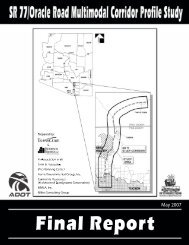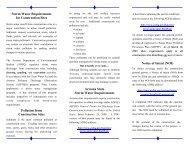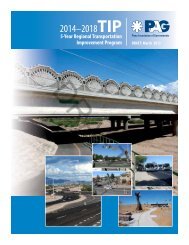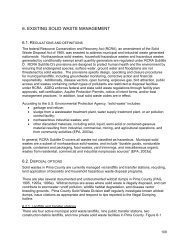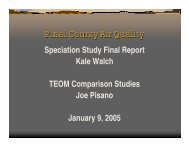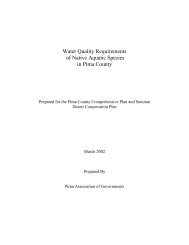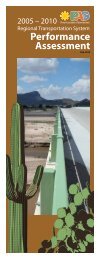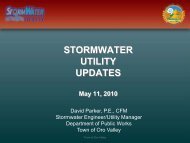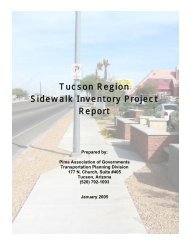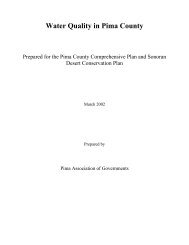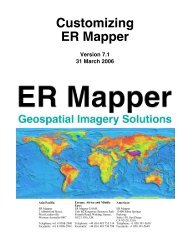Final Report - Pima Association of Governments
Final Report - Pima Association of Governments
Final Report - Pima Association of Governments
Create successful ePaper yourself
Turn your PDF publications into a flip-book with our unique Google optimized e-Paper software.
High Capacity Transit System Plan - <strong>Final</strong> <strong>Report</strong> June 2009<br />
HCT Implementation Strategy<br />
BRT service would extend from UA to TIA. It would share a station at the university with the<br />
Broadway Boulevard BRT route to allow easy transfers. Placement <strong>of</strong> a park‐and‐ride lot adjacent<br />
to the university station would provide a central location for travelers destined for TIA;<br />
management <strong>of</strong> long‐term parking would be required. Stops would be spaced one mile or farther<br />
apart, and TSP will be required.<br />
Existing and Programmed/Planned Transit Service<br />
Fixed‐route bus service is currently provided along Campbell Avenue, but no express bus service<br />
currently exists. Route 15 has a weekday ridership <strong>of</strong> approximately 1,800 passengers. The route,<br />
which runs between the Tohono Tadai Transit Center and Reid Park with a primary stop at UA,<br />
travels on Campbell Avenue from Roger Road to just south <strong>of</strong> 22nd Street. South <strong>of</strong> 22nd Street,<br />
there is no continuous transit service. Route 15 service during both weekdays and weekends was<br />
recently extended. No additional transit service within the corridor is currently planned or<br />
programmed.<br />
HCT Implementation Constraints<br />
Running an extension <strong>of</strong> the streetcar between the Health Sciences Center and Tucson Mall along<br />
Campbell Avenue could be problematic considering the lack <strong>of</strong> right‐<strong>of</strong>‐way to add dedicated<br />
HCT lanes and the heavy traffic volumes that the roadway carries. Widening Campbell Avenue<br />
would be cost‐prohibitive. If streetcar runs in the general purpose lanes, the forecasted level <strong>of</strong><br />
service on Campbell Avenue suggests that the streetcar will experience delays from general<br />
purpose traffic and may have an adverse impact on general purpose traffic as well. Unless<br />
dedicated streetcar right‐<strong>of</strong>‐way can be provided, implementation <strong>of</strong> this route will be difficult.<br />
Implementation <strong>of</strong> BRT service between UA and TIA is essentially unconstrained, assuming that<br />
BRT would run in general purpose lanes.<br />
An additional constraint is existing corridor ridership not being high enough for Very Small<br />
Starts eligibility.<br />
Implementation Plan<br />
• The success <strong>of</strong> the initial phase <strong>of</strong> the Tucson Modern Streetcar, measured by ridership as<br />
well as resulting redevelopment, will determine the viability <strong>of</strong> an extension between UA<br />
and Tucson Mall. To qualify for Very Small Starts funding, BRT should benefit at least<br />
3,000 riders.<br />
• As transit demand between UA and TIA increases, implementation <strong>of</strong> express bus should<br />
be considered prior to BRT.<br />
• Ensure that new development and redevelopment in the interim is “transit‐ready.” (See<br />
Section 9.0.)<br />
173



